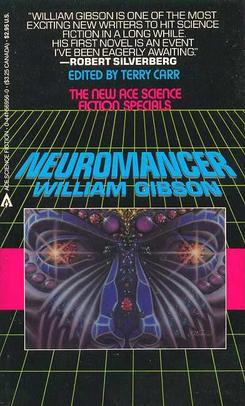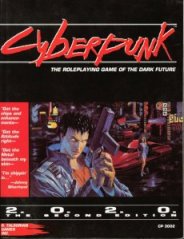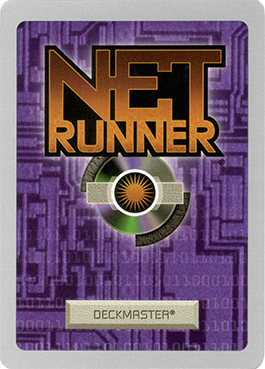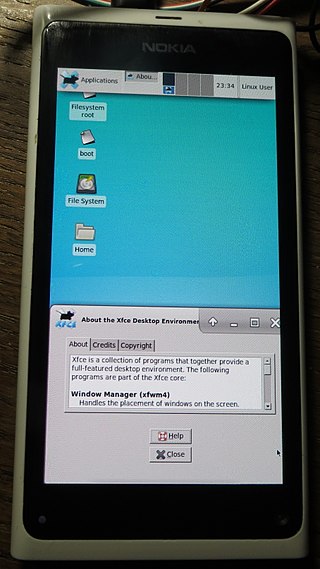Related Research Articles

Cyberpunk is a subgenre of science fiction in a dystopian futuristic setting that tends to focus on a "combination of lowlife and high tech", featuring futuristic technological and scientific achievements, such as artificial intelligence and cyberware, juxtaposed with societal collapse, dystopia or decay. Much of cyberpunk is rooted in the New Wave science fiction movement of the 1960s and 1970s, when writers like Philip K. Dick, Michael Moorcock, Roger Zelazny, John Brunner, J. G. Ballard, Philip José Farmer and Harlan Ellison examined the impact of drug culture, technology, and the sexual revolution while avoiding the utopian tendencies of earlier science fiction.

Cyberspace is an interconnected digital environment. It is a type of virtual world popularized with the rise of the Internet. The term entered popular culture from science fiction and the arts but is now used by technology strategists, security professionals, governments, military and industry leaders and entrepreneurs to describe the domain of the global technology environment, commonly defined as standing for the global network of interdependent information technology infrastructures, telecommunications networks and computer processing systems. Others consider cyberspace to be just a notional environment in which communication over computer networks occurs. The word became popular in the 1990s when the use of the Internet, networking, and digital communication were all growing dramatically; the term cyberspace was able to represent the many new ideas and phenomena that were emerging. As a social experience, individuals can interact, exchange ideas, share information, provide social support, conduct business, direct actions, create artistic media, play games, engage in political discussion, and so on, using this global network. Cyberspace users are sometimes referred to as cybernauts.

A hacker is a person skilled in information technology who achieves goals by non-standard means. Though the term hacker has become associated in popular culture with a security hacker – someone with knowledge of bugs or exploits to break into computer systems and access data which would otherwise be inaccessible to them – hacking can also be utilized by legitimate figures in legal situations. For example, law enforcement agencies sometimes use hacking techniques to collect evidence on criminals and other malicious actors. This could include using anonymity tools to mask their identities online and pose as criminals. Likewise, covert world agencies can employ hacking techniques in the legal conduct of their work. Hacking and cyber-attacks are used extra-legally and illegally by law enforcement and security agencies, and employed by state actors as a weapon of legal and illegal warfare.

Neuromancer is a 1984 science fiction novel by American-Canadian writer William Gibson. Considered one of the earliest and best-known works in the cyberpunk genre, it is the only novel to win the Nebula Award, the Philip K. Dick Award, and the Hugo Award. It was Gibson's debut novel and the beginning of the Sprawl trilogy. Set in the future, the novel follows Henry Case, a washed-up hacker hired for one last job, which brings him in contact with a powerful artificial intelligence.

William Ford Gibson is an American-Canadian speculative fiction writer and essayist widely credited with pioneering the science fiction subgenre known as cyberpunk. Beginning his writing career in the late 1970s, his early works were noir, near-future stories that explored the effects of technology, cybernetics, and computer networks on humans—a "combination of lowlife and high tech"—and helped to create an iconography for the information age before the ubiquity of the Internet in the 1990s. Gibson coined the term "cyberspace" for "widespread, interconnected digital technology" in his short story "Burning Chrome" (1982), and later popularized the concept in his acclaimed debut novel Neuromancer (1984). These early works of Gibson's have been credited with "renovating" science fiction literature in the 1980s.

Cyberpunk is a tabletop role-playing game in the dystopian science fiction genre, written by Mike Pondsmith and first published by R. Talsorian Games in 1988. It is typically referred to by its second or fourth edition names, Cyberpunk 2020 and Cyberpunk Red, in order to distinguish it from the cyberpunk genre after which it is named.

Netrunner is an out-of-print collectible card game (CCG) designed by Richard Garfield, the creator of Magic: The Gathering. It was published by Wizards of the Coast and introduced in April 1996. The game took place in the setting for the Cyberpunk 2020 role-playing game (RPG), but it also drew from the broader cyberpunk genre.

Count Zero is a science fiction novel by American-Canadian writer William Gibson, originally published in 1986. It is the second volume of the Sprawl trilogy, which begins with Neuromancer and concludes with Mona Lisa Overdrive, and is a well-regarded early example of the cyberpunk subgenre.

A personal firewall is an application which controls network traffic to and from a computer, permitting or denying communications based on a security policy. Typically it works as an application layer firewall.
GURPS Cyberpunk is a genre toolkit for cyberpunk-themed role-playing games set in a near-future dystopia, such as that envisioned by William Gibson in his influential novel Neuromancer. It was published in 1990 after a significant delay caused by the original draft being a primary piece of evidence in Steve Jackson Games, Inc. v. United States Secret Service.
Internet security is a branch of computer security. It encompasses the Internet, browser security, web site security, and network security as it applies to other applications or operating systems as a whole. Its objective is to establish rules and measures to use against attacks over the Internet. The Internet is an inherently insecure channel for information exchange, with high risk of intrusion or fraud, such as phishing, online viruses, trojans, ransomware and worms.

Tom Maddox was an American science fiction writer, known for his part in the early cyberpunk movement.
A security hacker is someone who explores methods for breaching defenses and exploiting weaknesses in a computer system or network. Hackers may be motivated by a multitude of reasons, such as profit, protest, information gathering, challenge, recreation, or evaluation of a system weaknesses to assist in formulating defenses against potential hackers.

Wireless security is the prevention of unauthorized access or damage to computers or data using wireless networks, which include Wi-Fi networks. The term may also refer to the protection of the wireless network itself from adversaries seeking to damage the confidentiality, integrity, or availability of the network. The most common type is Wi-Fi security, which includes Wired Equivalent Privacy (WEP) and Wi-Fi Protected Access (WPA). WEP is an old IEEE 802.11 standard from 1997. It is a notoriously weak security standard: the password it uses can often be cracked in a few minutes with a basic laptop computer and widely available software tools. WEP was superseded in 2003 by WPA, a quick alternative at the time to improve security over WEP. The current standard is WPA2; some hardware cannot support WPA2 without firmware upgrade or replacement. WPA2 uses an encryption device that encrypts the network with a 256-bit key; the longer key length improves security over WEP. Enterprises often enforce security using a certificate-based system to authenticate the connecting device, following the standard 802.11X.

Neuromancer is an adventure video game developed by Interplay Productions and published by Mediagenic. It was released in 1988 for the Amiga, Apple II, Apple IIGS, Commodore 64, and MS-DOS. It was loosely based on William Gibson's 1984 novel of the same name and set within both the fictional "real world" and the extensively realized and detailed world of cyberspace. It has a soundtrack based on the Devo song "Some Things Never Change" from their album Total Devo. Writer Timothy Leary had sub-contracted the rights to a video game adaptation of the novel, and eventually brought the project to Interplay to develop.
Computer security software or cybersecurity software is any computer program designed to influence information security. This is often taken in the context of defending computer systems or data, yet can incorporate programs designed specifically for subverting computer systems due to their significant overlap, and the adage that the best defense is a good offense.

The hacking of consumer electronics is an increasingly common practice that users perform to customize and modify their devices beyond what is typically possible. This activity has a long history, dating from the days of early computer, programming, and electronics hobbyists.
Mobile security, or mobile device security, is the protection of smartphones, tablets, and laptops from threats associated with wireless computing. It has become increasingly important in mobile computing. The security of personal and business information now stored on smartphones is of particular concern.
The following outline is provided as an overview of and topical guide to computer security:
In cybersecurity, cyber self-defense refers to self-defense against cyberattack. While it generally emphasizes active cybersecurity measures by computer users themselves, cyber self-defense is sometimes used to refer to the self-defense of organizations as a whole, such as corporate entities or entire nations. Surveillance self-defense is a variant of cyber self-defense and largely overlaps with it. Active and passive cybersecurity measures provide defenders with higher levels of cybersecurity, intrusion detection, incident handling and remediation capabilities. Various sectors and organizations are legally obligated to adhere to cyber security standards.
References
- 1 2 3 "Ice". The Jargon File . 2003-10-27. Archived from the original on 2008-12-04. Retrieved 2008-11-21.
- 1 2 William Gibson (1984). Neuromancer . Ace Books. ISBN 0-441-56959-5.
- ↑ Wall, D.S. (2012). "The Devil Drives a Lada: the social construction of hackers as cybercriminals". In Gregoriou, C. (ed.). The Construction of Crime. Palgrave Macmillan. pp. 4–18.
- ↑ Burrows, Roger (1997). "Cyberpunk as Social Theory" (PDF). In Westwood, Sallie; Williams, John (eds.). Imagining Cities: Scripts, signs, memories. London: Routledge. pp. 235–48.
- ↑ Edwards, M (8 December 1999). "BlackICE". ITPro Today. Retrieved 16 July 2020.
- ↑ Naraine, Ryan. "IBM kills off BlackICE firewall". ZDNet. CBS Interactive. Retrieved 16 July 2020.
- ↑ Kwan, Matthew (1997). "The design of the ICE encryption algorithm" (PDF). Fast Software Encryption. Lecture Notes in Computer Science. Vol. 1267. Springer-Verlag. pp. 69–82. doi:10.1007/BFb0052335. ISBN 978-3-540-63247-4.
{{cite book}}:|journal=ignored (help) - ↑ Haase, Enver. "JustIce". GitHub .
- ↑ Howard, Alexander B. (2009-04-28). "ICE Act would restructure cybersecurity rule, create White House post". SearchCompliance. Archived from the original on 2009-11-08. Retrieved 2010-05-07.
- ↑ "S.921 - U.S. ICE Act of 2009". OpenCongress. Archived from the original on 2010-08-31. Retrieved 2010-05-07.
- ↑ "Fire and I.C.E.". Phantom 2040. Season 1. Episode 4.
- ↑ "Hacker". StarCrawlers Wiki.